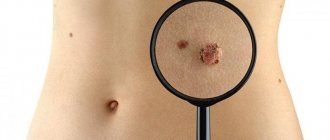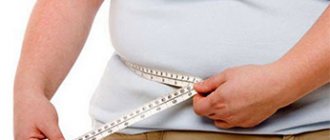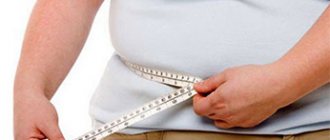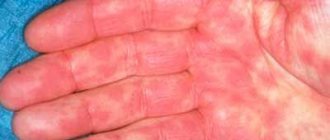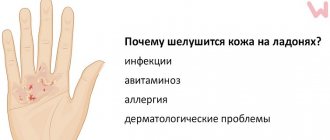Author
: Grachev Ilya Illarionovich
Editor
: Efremov Mikhail Mikhailovich
Date of publication: 09/24/2018 Date of update: 06/08/2020
Regular psoriatic plaques can be seen not only on the elbows. No less often they are located on the skin of the anterior (extensor) surface of the knee joint. In some patients they remain unchanged for years, while in others they spread to neighboring and distant parts of the body. There are other manifestations of psoriasis on the legs. When should they be treated and is it worth doing if the disease does not progress? The answer to this question will be given by the specialists of the Paramita clinic.
Why does psoriasis develop on the legs?
Psoriasis on the legs is a chronic skin pathology that has a hereditary predisposition. The development of the disease is facilitated by the influence of predisposing factors. Factors predisposing to the development of psoriasis on the legs:
- Limb injuries - abrasions, cracks, wounds. In people prone to this pathology, they often become inflamed, accompanied by itching, and scratching. Against this background, psoriatic rashes appear. These causes most often cause psoriasis in the knee joints in children, adolescents and athletes.
- Skin diseases and foot abrasions. The disease especially often develops against the background of fungal infections. It is important to wear tight shoes, in which the feet sweat and get injured.
- Metabolic disorders, obesity, diabetes mellitus, endocrine diseases, age-related hormonal imbalances, pregnancy. Any hormonal imbalance can cause the onset of the disease.
- Any chronic processes and foci of infection leading to intoxication of the body.
- High emotional, mental and physical stress.
- Improper, irregular diet, intestinal dysbiosis.
- Immunity disorders.
Psoriasis of any localization can spread throughout the body, so do not delay treatment.
See how easily the disease can be cured in 10-12 sessions.
Exposure to one or more predisposing factors causes a chain reaction in the body:
- metabolism is disrupted;
- biologically active substances are released that stimulate the rapid division of surface cells of the skin epithelium; the formation of scales and peeling begins;
- Antibodies to your own skin cells are formed in the blood, an autoimmune inflammatory process begins - characteristic papules appear.
Psoriasis on the legs can develop on different parts of the skin, but most often the rash appears on the knees and feet. It also looks different.
Why does plaque psoriasis occur?
Scientists still cannot come to a consensus as to why plaque psoriasis occurs.
Among the main versions, a hereditary factor is put forward. But cases of the disease are increasingly being identified among people who did not have this pathology in their family. Therefore, today the main cause of the development of psoriasis is considered to be dysregulation of genes responsible for the immune response and for the formation of the skin barrier. Additionally, experts have identified a group of factors that could potentially trigger the development of plaque psoriasis or aggravate the course of psoriasis. These reasons include:
- stress;
- acute and chronic infectious diseases, especially tonsillitis;
- unbalanced diet with a predominance of fatty, spicy and salty foods, sweets and industrial confectionery products;
- presence of bad habits (drinking alcohol, smoking);
- disruptions in the functioning of the endocrine system, hormonal imbalance;
- living in environmentally unfavorable areas, working in hazardous industries;
- taking certain medications.
IMPORTANT! Plaques on the skin sometimes look scary, which is why many people think that the disease can be contracted through everyday contact, as a result of touching. Psoriasis is an autoimmune pathology. This is not a contagious disease, but a feature of the functioning of the body. A person with characteristic skin plaques is not contagious. And it is necessary to talk about this in society, because due to limited contacts and obvious exclusion of people, the patient may become depressed. This situation does not contribute to recovery, but only aggravates the course of the disease.
Psoriasis on the knees
The manifestation of psoriatic rashes on the extensor surface of the knee joints is typical.
Psoriasis on the knees begins with the appearance of a small round or oval-shaped spot. The spot gradually turns into a papule with a raised, inflamed base. The early plaque is covered with silvery scales on top and is surrounded by a brighter corolla that rises above its surface and has no scales. If you scratch the papule, first the appearance of a stearin stain appears, and then a thin transparent film. Further exposure to the film is accompanied by the appearance of droplets of blood—blood dew—on its surface. In the initial stage of psoriasis of the legs (also called progressive), there may be one or two papules, then several more appear and they grow, merge with each other, forming large plaques of various configurations. The appearance of new rashes at the site of injury to the skin - scratches, abrasions, etc. is typical.
Psoriasis often stops at the initial stage and plaques in the knees, feet, and legs can be seen for several years and even decades. Such plaques are called duty plaques. With additional exposure to provoking factors, psoriasis can enter a progressive stage at any time, spreading from the legs to other parts of the body.
The next period is called stationary. The spread of the psoriatic rash stops and it looks the same all the time. After some time, the final regressive stage begins, when the rash gradually fades. The process can take place in two directions:
- from the center to the periphery - a pink corolla forms around the papule;
- from the periphery to the center - the corolla is white.
Gradually, white or brownish pigment spots form at the site of the rash. The process proceeds in waves: exacerbation is replaced by remission and vice versa.
Atypical type of psoriasis on the legs
Psoriatic rashes may have uncharacteristic localization and appearance. This form of psoriasis is localized not on the extensor side, but on the flexor side of the leg joints, in the area of skin folds. Since the skin in this area constantly sweats, the scales on the rash are not always noticeable in the initial stage. Papules in the initial stage of the disease may look like ordinary prickly heat and be accompanied by severe itching.
Subsequently, the process spreads to surrounding areas and acquires a characteristic appearance. The stationary and regressive stages proceed in the same way as in a typical disease.
Plantar type of psoriasis
Psoriasis on the legs may first appear on the soles of the feet. In this case, the following may appear on the feet:
- typical rashes in the form of papules at the initial stage; over time, they merge with each other to form large plaques; this is a typical form, it proceeds in the same way as in other areas;
- the skin of the soles becomes covered with flaky itchy spots, it is dry, thickened (psoriatic calluses), and covered with cracks; this is the so-called horny form of the disease; cracks in the affected areas of the skin of the feet are very painful, which creates great problems when wearing shoes;
- pustular (purulent) rashes appear on the soles, merging into large lakes - this is Barber's pustular psoriasis; after the ulcers dry out, brown crusts form, at the site of which red spots remain; the toes may also be affected;
Treatment methods for psoriasis on the legs
Treating psoriasis on the legs is a difficult task. Psoriasis should be treated comprehensively. It is recommended for patients with psoriasis on the legs:
- optimization of the daily routine, combining an active lifestyle with rest and healthy sleep at night;
- avoiding smoking and drinking any types of alcoholic beverages;
- eliminating stress;
- avoiding high physical activity with associated sweating;
- exclusion of contact (wrestling, boxing) sports;
- proper regular nutrition; Salty, sour, spicy foods, as well as vegetables containing essential oils that irritate the skin are not recommended; limited consumption of meat, consumption of large quantities of vegetables and fruits; drink plenty of fluids: drink plus 6 glasses per day added to the rest of the liquid;
- wearing shoes made of genuine leather or textiles with low heels that do not compress the feet;
- when playing sports, try not to injure the knee area;
- timely elimination of fungal, bacterial and viral infections of the feet;
- regular treatment under the supervision of a physician of all chronic pathologies, elimination of foci of infection;
- daily foot washing using hypoallergenic gels or baby soap; cutting toenails; after this, a moisturizing hypoallergenic cream should be applied to the skin;
- wearing socks made of cotton fabrics in light colors (dyes can provoke an exacerbation of psoriasis).
Red spots on the skin after stress
Diagnosis of skin diseases
Drug therapy
The choice of medications depends on the nature of psoriasis, the stage of the disease, its course and spread, the age of the patient, and the presence or absence of concomitant pathology. The goal of drug therapy is to eliminate the symptoms of the disease, which leads to an improvement in the patient’s quality of life. With the right approach to the treatment process, you can constantly maintain psoriasis in a state of remission, but you cannot guarantee its complete cure.
Preference is given to step-by-step external treatment with alternation of modern topical drugs belonging to different groups. For severe and widespread forms of psoriasis of the legs, individually selected combination treatment with general and local drugs is prescribed.
Local treatment
For local therapy the following are used:
- Ointments, creams, solutions based on glucocorticoid hormones (GCS). These remedies are widely used in the treatment of all forms of psoriasis of the legs. They perfectly relieve inflammation, swelling, itching, suppress proliferation (rapid division) of epithelial cells, inhibiting peeling. Combination ointments are also used, which, in addition to GCS, contain keratolytics - substances that dissolve keratinized epithelial cells and ensure rapid penetration of GCS to the cells (Diprosalik). But if the rash spreads quickly and aggressively, keratolytics can irritate the skin, so they are used with caution.
- Ointments, creams and lotions based on a synthetic analogue of vitamin D (Davonex). The drug actively affects the metabolism in cells, suppressing processes that contribute to the occurrence of disorders. Recently, a drug has been produced that, in addition to a synthetic analogue of vitamin D, includes an active substance from the GCS group (Daivobet). Modern step-by-step therapy includes the use of Daivonex first (in the early stages), and then Daivobet (during follow-up treatment).
- Keratolytic agents (salicylic acid) - soften rough layers of dead cells, improve access to cells of other drugs. Suitable for the treatment of horny psoriasis of the soles.
- Ointments and pastes based on activated zinc - have an anti-inflammatory and antiseptic effect, well suited for eliminating psoriasis of the feet and atypical forms.
- Ointments, creams, gels based on tar - have an anti-inflammatory, absorbable, antiseptic, analgesic effect. Suitable for eliminating the symptoms of plaque psoriasis on the feet in the stationary stage.
General treatment
General therapy is prescribed for a widespread process, as well as for the development of severe pustular forms of the disease, when local treatment is ineffective. Patients are prescribed:
- In order to eliminate intoxication and suppress allergies:
- calcium supplements, hemodez;
- antihistamines – Suprastin;
- In order to suppress the rapid proliferation (division) of cells in the lesions:
- drugs based on corticosteroids - administered in the form of infusions, injections or taken orally;
- cytostatics (Metoltrexate);
- aromatic retinoids (Acitretin).
- In order to suppress the excessive sensitivity of the immune system - immunosuppressants (Cyclosporin-A);
- In order to eliminate the symptoms of inflammation and tissue swelling, itching and pain:
- drugs based on corticosteroids;
- biological drugs (Remicade) - contain proteins that recognize and neutralize substances that support inflammation.
- In order to eliminate neuropsychic symptoms:
- sedatives (sedatives (Novopassit).
Symptoms of the disease
Spots from light pink to deep red, covered with small silvery scales, are usually located in the elbows and knees, hidden under the hair on the head, affect the skin in the lumbar and buttock areas, and are also often found in the genital area. As the disease worsens, small spots on the skin covered with scales tend to unite and merge, and over time they increase in size, affecting new areas of the body.
Figure 1. Plaque psoriasis at the hairline.
Effective methods for treating psoriasis on the legs
The following methods used in our clinic have been proven to be highly effective:
- PRP therapy - the essence of the method is that the patient is injected with his own blood enriched with platelets; Initially, blood is taken from a vein and injected pointwise into the affected areas of the skin of the legs; this leads to improved metabolic processes and suppression of the spread of psoriasis; helps well with all forms of disease;
- autohemotherapy - intramuscular injection of blood taken from the patient’s vein; has a general stimulating effect on the body;
- herbal medicine – the use of herbs and other medicinal plants. They are used as part of complex therapy to reduce the drug load on the patient’s body;
- acupuncture (acupuncture) is one of the methods of reflexology, the oldest method practiced by Chinese doctors; influence on special acupuncture points (AP) on the body and through them on various organs and tissues; specialists who are fluent in this technique can eliminate psoriatic rashes without the use of medications;
- vacuum therapy – exposure of the AT to rarefied air; for this purpose, special jars or devices are used;
- other methods of reflexology - cauterization with wormwood cigarettes, acupressure, auriculotherapy (impact on reflex points on the ear), etc.
How is leg psoriasis treated at Paramita Clinic?
A special feature of the Paramita clinic is the use of only effective methods of treating psoriasis on the legs at an affordable price. Both the most advanced European techniques and traditional oriental ones are used.
The correct choice and application of one or another method of therapy is possible only if the doctor has appropriate training and clinical experience. The clinic's doctors are fluent in all known methods of treating psoriasis, so it always takes place without side effects. All of them were trained in traditional healing methods in China and Tibet.
To avoid relapses, it is necessary to eliminate the cause of the disease.
Read more about our unique method of treating psoriasis
You can learn about the quality of treatment provided by Paramita specialists from reviews, as well as simply by asking visitors, because many of them are systematically treated at the clinic, maintaining a state of remission for years.
CHOLESTEROL PLAQUES: RISK FACTORS, TREATMENT, PREVENTION
Cholesterol plaques are formations on the walls of blood vessels that provoke the development of diseases of the cardiovascular system. Cholesterol plaques begin to form on the walls of the arteries and grow over many years, slowly blocking blood flow. Even worse, the plaque may suddenly rupture, causing a blood clot (thrombus) to form over the rupture site, which can lead to a stroke or myocardial infarction. Blocked arteries caused by the growth of cholesterol plaques and blood clots are the leading cause of death in developed countries. Lowering your cholesterol levels and eliminating other risk factors can help prevent the growth of cholesterol plaques. In some cases, it is even possible to achieve a reduction in these formations, which in turn helps to get rid of vascular and heart diseases.
Cholesterol plaques and atherosclerosis
The process of formation of cholesterol plaques, in which not only the formation of these fatty deposits occurs, but also the hardening of the arteries is called atherosclerosis. LDL or “bad cholesterol” is the building block of cholesterol plaques. Vascular atherosclerosis develops slowly and asymptomatically, often beginning in childhood (usually at the age of 10-12 years). Eventually, the arteries can become so blocked that blood flow can be cut off altogether. Atherosclerosis of blood vessels often causes heart attacks, strokes and peripheral artery disease. All these conditions can be classified as cardiovascular diseases. Cardiovascular disease is the No. 1 killer in developed countries, causing more than 900,000 deaths annually in America alone.
What are cholesterol plaques?
Cholesterol plaques begin to form on the walls of the arteries. Long before they can be called plaques, they appear as fatty streaks in large arteries, even in some teenagers. It is these bands that are the precursors of cholesterol plaques. They cannot be detected through diagnostic procedures, but researchers have discovered them during autopsies of young victims of accidents and violence. Atherosclerosis develops over many years. During this period, a complex process of formation of cholesterol plaques occurs, which includes:
Damage to arterial endothelium . The smooth, delicate lining of blood vessels is called endothelium. High cholesterol, smoking, high blood pressure (hypertension) or diabetes can damage the endothelium, creating space for cholesterol to leak into the artery wall.
Cholesterol invasion . “Bad cholesterol” (LDL), circulating in the blood, penetrates the damaged endothelium, after which it begins to accumulate in the artery wall.
Plaque formation . Macrophages (scavenger cells), which process various harmful substances, bacteria and cholesterol, also fill cholesterol plaques, and over many years the toxic mass of cholesterol and these cells forms a dense plaque on the artery wall.
Why are cholesterol plaques dangerous?
Once cholesterol plaques form on artery walls, they can behave in a variety of ways.
They can grow into the artery wall . Cholesterol plaques may stop growing or may grow into the inner wall of a blood vessel without impeding blood flow.
Plaques can slowly grow, increasingly blocking blood flow . Slow-growing cholesterol plaques may or may not cause any symptoms—even when the arteries are severely blocked.
Cholesterol plaques can suddenly rupture—worst-case scenario . This provokes blood clotting and blood clot formation, which can lead to myocardial infarction or stroke.
The formation of cholesterol plaques causes the development of three main types of cardiovascular diseases:
Cardiac ischemia . The presence of plaque in the arteries of the heart may not cause any symptoms or may lead to chest pain, a condition called angina. The sudden rupture of a cholesterol plaque and the formation of a blood clot in an artery can block this blood vessel, leading to the death of the heart muscle (myocardial infarction).
Cerebrovascular disease . Cholesterol plaques can rupture in one of the brain's arteries, causing a stroke and leading to permanent brain damage. Blocked blood vessels can also cause transient ischemic attacks (TIAs). A TIA causes symptoms similar to those of a stroke, but they are temporary and do not damage the brain as much. However, patients experiencing a TIA are at very high risk of developing a stroke, and it is important to begin appropriate treatment as quickly as possible and take all necessary precautions.
Peripheral arterial diseases . Blocked arteries in the legs can lead to pain when walking and poor wound healing due to poor circulation. A severe stage of the disease can lead to amputation of limbs.
Prevention
Over time, atherosclerosis progresses and cholesterol plaques increasingly narrow the ducts of important blood vessels. How to prevent the development of this insidious disease? There are nine risk factors that are responsible for up to 90% of all heart attacks. These risk factors include:
smoking
high cholesterol
high blood pressure
diabetes
abdominal obesity
stress (see How to get rid of stress )
insufficient consumption of fruits and vegetables
excessive alcohol consumption
sedentary lifestyle
You may notice that almost all of them are quite common. Experts agree that reducing and completely eliminating risk factors leads to a reduced risk of developing cardiovascular disease. For people with moderate or end-stage atherosclerosis, daily baby aspirin may be indicated to help prevent blood clots. Before you start taking baby aspirin, check with your doctor because... this drug may cause various side effects.
How to get rid of cholesterol plaques?
If cholesterol plaques have already formed, then, as a rule, this is forever. Although with effective treatment their growth can be slowed down or even stopped. Some evidence suggests that with persistent treatment, cholesterol plaques may even shrink slightly in size. The results of one significant study showed that after reducing blood cholesterol levels by 50%, cholesterol plaques decreased in size by 10%. The best way to treat cholesterol plaques is to prevent their formation or progression of the disease. This can be achieved through lifestyle changes and, if necessary, appropriate treatment.
Medications and lifestyle changes to reduce the risk of atherosclerosis
Reducing and eliminating risk factors leading to the development of atherosclerosis helps to slow down or stop the development of cholesterol plaques. Ways to reduce the amount of cholesterol in the body are:
taking medications that lower “bad cholesterol” levels
taking medications to reduce high blood pressure
use of folk remedies healthy diet
regular physical activity
to give up smoking
These methods won't help clear your arteries of cholesterol plaque, but they can go some way to reducing your risk of heart attacks and strokes. There are various medications that can help you lower your blood cholesterol levels. Among them:
statins
fibrates
niacin
bile acid sequestrants
Procedures to improve blood flow
Using invasive procedures allows doctors to see the condition of the arteries and improve blood flow or restore it by using other vessels to bypass the blocked artery. These procedures include:
Angiography, angioplasty and stenting . Using a catheter inserted into an artery in the leg and X-rays, doctors can examine diseased arteries. This procedure is called cardiac catheterization. A tiny air balloon is inflated in the area where cholesterol plaque has severely narrowed the lumen of the vessel, after which a metal stent is implanted there, which will subsequently help keep the blocked arteries open.
Bypass surgery . Surgeons take a healthy vessel from the leg or chest and use it to bypass the area of the blocked artery, thereby restoring blood circulation.
These procedures cannot be called absolutely safe, because... they carry a certain risk of complications. A patient may be referred for one of these procedures only if he has severe symptoms associated with the presence of cholesterol plaques and cardiovascular diseases associated with atherosclerosis.
Head of the therapeutic department Safonov A.A.

